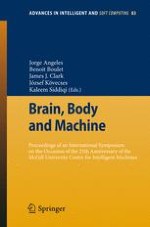2010 | Book
Brain, Body and Machine
Proceedings of an International Symposium on the Occasion of the 25th Anniversary of the McGill University Centre for Intelligent Machines
Editors: Jorge Angeles, Benoit Boulet, James J. Clark, József Kövecses, Kaleem Siddiqi
Publisher: Springer Berlin Heidelberg
Book Series : Advances in Intelligent and Soft Computing
